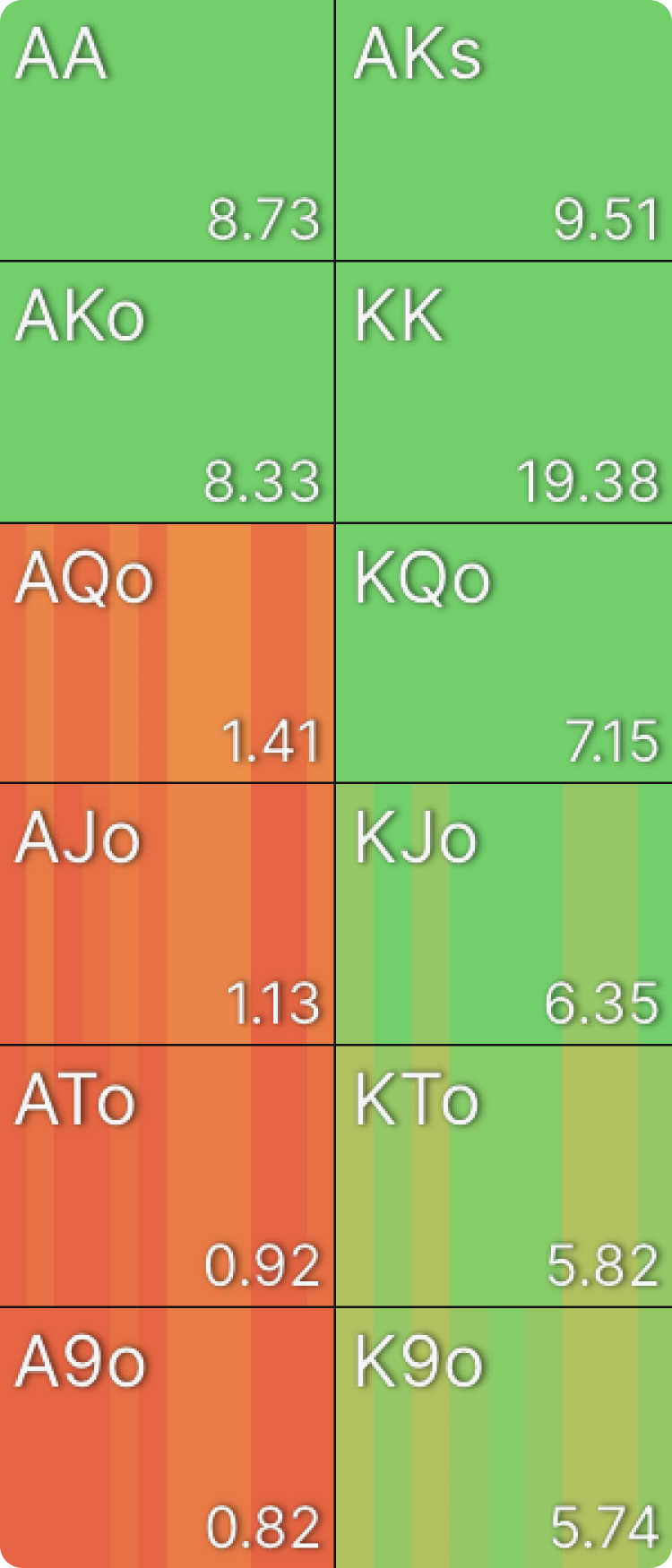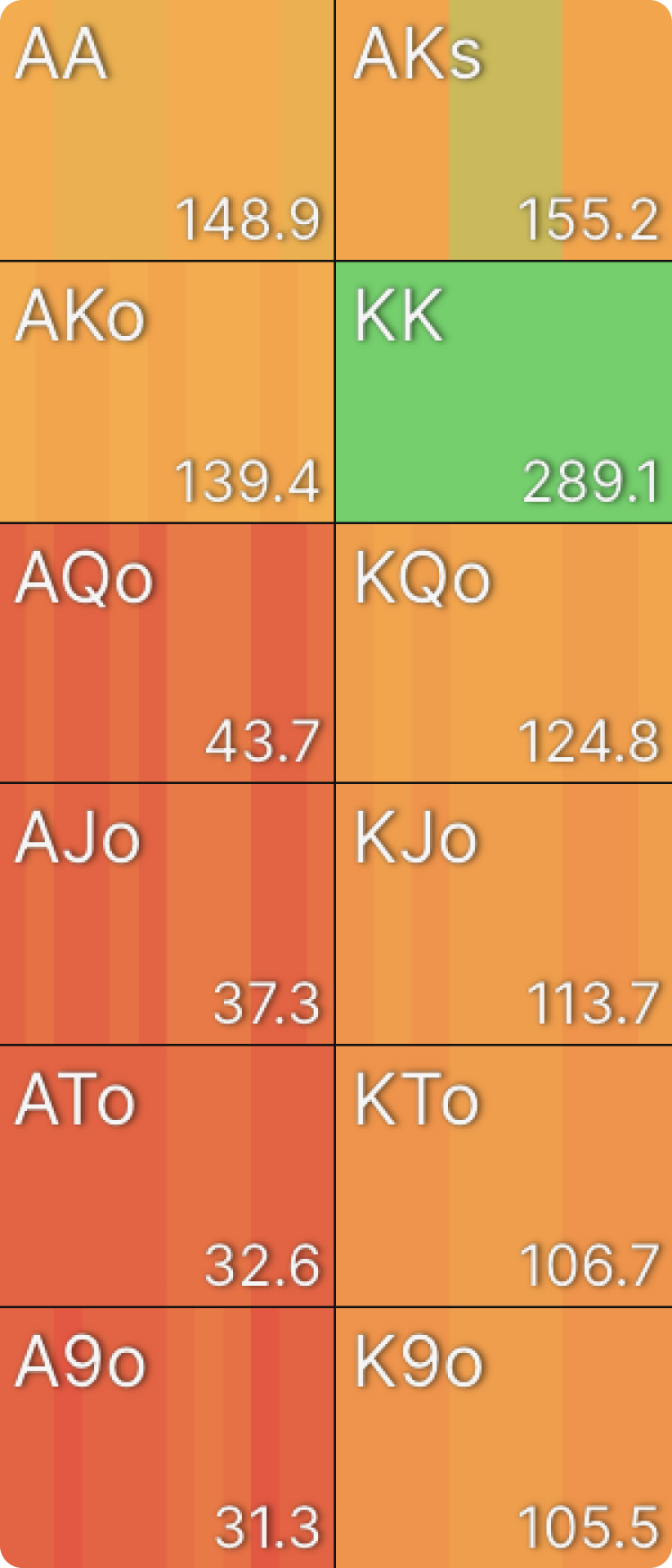I’d Rather Be Drawing
Which is the better hand on a K♥8♦5♦ flop: K♠T♣ or 7♥6♥?
OK, I’ll admit I didn’t provide enough information to answer that question. Let’s say we’re 100bb deep in a single-raised MTT pot, and it’s early in the tournament, so we’re looking at ChipEV ranges. The CO has just continuation bet 33% pot with K♠T♣ on the K♥8♦5♦ flop, and the BTN holds 7♥6♥. Who has the higher EV?
Perhaps you deduced that I wouldn’t be asking this question unless the answer was 7♥6♥. Despite being “just” a draw, it has an EV of 5.81bb, while K♠T♣ has an EV of 5.36bb.
This is not merely a function of position. K♠T♣ has an almost identical EV (5.37bb) in BTN’s hands. In other words, even in the same position, facing the same bet, the draw performs better than the “made hand.”
This is a function of stack depth because K♠T♣ is, of course, the higher-equity hand, with about 63% equity in a mano-a-mano matchup. The equity-vs-range difference is even more dramatic. CO’s K♠T♣ has about 75% equity vs BTN’s range, while 7♥6♥ has only about 40% equity vs CO’s betting range. If there were no more money to wager, you’d rather have the top pair.
In our example, 7♥6♥ benefits from “visibility.” The player with 76 will more frequently know whether they have the best hand, enabling them to over-realize their equity by value betting or bluffing.
The player with KT hates facing these bets, because they will generally not have visibility. That means they will have tough decisions on future streets. On blank turns, they will have to choose whether to risk betting into stronger hands, against which they are way behind, in order to deny equity and get value from the many weaker hands in the opponent’s range. When draws complete, they will often face big bets and are forced to make no-win decisions about whether to bluff catch or surrender the pot.
Underscoring this point, KT’s EV improves by more than 10%, from 5.36bb to 5.99bb, if we give them the T♦ instead of the T♣. The diamond provides more than just a flush draw; it’s also a blocker that makes value betting and bluff catching more profitable on three-diamond boards. Even the T♥ improves their EV to 5.42bb.
What’s Your Kicker?
What really improves the EV of top pair is having a stronger kicker. This image shows the EVs for CO, but BTN’s range follows a similar pattern:
What really improves the EV of top pair is having a stronger kicker.
What we see here is that KT does not perform much better than K9, but after that, the improvements are dramatic, with KJ doing about 0.5bb better than KT, KQ doing another 0.8bb better yet, and AK getting another 1.2bb on top of that! (Suits make a difference as well, as we saw before, but the general trend remains the same.)
Top pair with a stronger kicker performs *disproportionately better* than the lower kickers.
It’s not exactly headline news to observe that better hands are better, but this is not just a matter of having more equity. Top pair with a stronger kicker performs disproportionately better than the lower kickers. These hands both have more equity and realize that equity better:
All these top pair hands will have similar difficulties vis-a-vis the draws in BTN’s range. On the flop, they do not gain terribly much from growing the pot against hands like 7♥6♥. The difference for AK and KQ is that they will benefit from growing the pot against the King-x portion of BTN’s range, while their own weaker King-x is dominated by most of these hands. Hands like K9 and KT often win the pot, regardless of whether they bet or check, but are not likely to win more than that because they are not favored as the pot gets larger. The profit garnered by AK and KQ above and beyond their equity comes not primarily from the draws in BTN’s range but from the dominated pairs.
That this board offers so many draws is a big part of why CO does not c-bet frequently, only about 30% of the time. Let’s see how our example hands, K♠T♣ and 7♥6♥, stack up on various turns after a 33% pot continuation bet from CO.
For comparison, here’s a chart showing the relevant metrics on the flop:
A Blank Turn (2♠)
A modest made hand can be thought of as a draw to a blank turn.
A modest made hand like KT can be thought of as, in part, a “draw” to a blank turn. Despite not improving in rank, KT gains a lot of EV when draws miss. Some of this EV gain is also attributable to the pot being larger than it was on the flop, but even as a percentage share of the pot, KT’s EV is greater on the 2♠ turn than it was on the flop.
However, it still does not over-realize its equity. The threat of putting money in from way behind remains significant, and it will face tough decisions on many rivers. Indeed, even checking and facing a 20% pot bet yields a slight decline in pot share. Against larger bets, KT fares much worse.
Blank turns, of course, are bad for draws. They lose equity and EV but continue to dramatically over-realize equity because of their ability to bluff or value bet rivers. Indeed, 7♥6♥ retains much of its EV even when facing a 200% pot turn bet, whereas K♠T♣ drops to 0 EV and becomes indifferent between calling and folding.
A Flush Turn (2♦)
A diamond is bad for both of these hands, but it is worse for 7♥6♥, which loses not only much of its equity but also its equity over-realization. Yes, it can bluff to represent the flush, but it no longer has any draws to the nuts. Two of its straight outs put four diamonds on the board, which is a disaster, but even on a 4♠ river, the risk of a flush reduces the opponent’s incentive to pay off with worse.
KT, meanwhile, has good showdown value as long as the pot remains small. Its EV starts to drop off when facing bets or raises.
A Heart Turn (2♥)
For KT, the 2♥ is good for the same reasons as the 2♠. It doesn’t improve many hands that weren’t already ahead, though the second draw on the board will lead to more tricky river situations.
For 7♥6♥, picking up a flush draw is, of course, better than not, but any turn that doesn’t make it a straight represents a net loss of pot share. That even one of the best non-straight turn cards results in a loss of pot share hints at just how much this hand depends on making a straight for its EV. On that note…
The 6♠
Turning third pair is actually less good for 7♥6♥ than turning a flush draw. It’s a bump in equity, but the equity is extremely difficult to realize. When this hand does not river a straight, it will face value bets from many better hands as well as bluffs from most worst hands, which will bury its EV beneath a pile of no-win decisions.
Straight equity is low but dramatically over-realized. Pair equity is higher but dramatically under-realized.
The EQR of 80-90% is misleading, as this hand really has two different sources of equity. It has the straight equity, which is low but dramatically over-realized, and the pair equity, which is higher but dramatically under-realized.
For KT, this is a fairly neutral card. It presents a few new threats in the form of straights and two pairs, but it also fades the most imminent threat of the flush draw.
The 4♠
Turning the nuts is an excellent poker strategy, extremely good for one’s equity and equity realization.
This is not a bad card for KT, either. Straights are a very small part of BTN’s range, which is why the reward for making one is so high. The 4♠ does not improve flush draws or make as many two pairs as the 6♠, so it’s actually a pretty neutral turn for KT.
Chasing and Implied Odds
We’ll conclude by returning to the K♥8♦5♦ 2♠ board. Suppose you were BTN facing a 200% pot continuation bet from CO. Which hand would you rather have: Q♦7♦ or 7♥6♥?
The Q7 has nine outs to a flush and 35% equity, while the 76 has eight outs to a straight, two of which also make flushes possible, and just 23.4% equity.
Once again, however, I wouldn’t ask if the answer was obvious. Q♦7♦ actually has 0EV, making it indifferent between calling and folding, while 7♥6♥ has 4.38bb in EV.
Q♦7♦ faces the same problem as 7♥6♥ on diamond rivers: it’s a strong hand, but not the nuts. BTN has too many flush draws to call with all of them at this price. Such a strategy could be exploited by an opponent who simply check-folded diamond rivers, as BTN would not have enough bluffing candidates to balance all their flushes. BTN never folds Ace- or King-high flush draws to this bet, and they never fold combo draws. But Queen- and Jack-high flushes are indifferent. And T♦7♦ is a pure fold even though it, too, has better equity than 7♥6♥.
As we saw on the 4♠ turn, 7♥6♥ realizes equity well precisely because the open-ended straight draw is a much smaller part of BTN’s range than flushes are on diamond rivers. This hand performs a function few others can, which is to make a monster on a relatively innocuous river card. It also provides bluffs on diamond rivers, when bluffing candidates are otherwise hard to find. These bluffs are not terribly profitable at equilibrium, earning roughly 1% of the pot, but they are +EV, which is not always the case with river bluffs.
Conclusion
Q♦7♦ suffers from the same problem we’ve seen with K♠T♣ throughout this article. Both make reasonably strong hands that will often win the pot when they “hit.” But they will struggle to put more money into the pot as a big favorite after getting there, and that matters in deep-stacked scenarios.
With a lot of money still to be wagered, a hand’s value comes not primarily from its rank but from being “best in class.” On King-high flops, CO has many top pair hands, and the best ones earn disproportionately more than the worst. On diamond rivers, BTN has many flushes, and the best ones earn disproportionately more than the worst.
Thus, in deep-stacked scenarios, draws to rare monsters can be worth more than draws to higher-ranked but more common monsters. They can even be worth more than so-called “made hands,” a distinction which should appear largely meaningless after digesting the analysis here.
Author
Andrew Brokos
Andrew Brokos has been a professional poker player, coach, and author for over 15 years. He co-hosts the Thinking Poker Podcast and is the author of the Play Optimal Poker books, among others.


























































































































































































































































